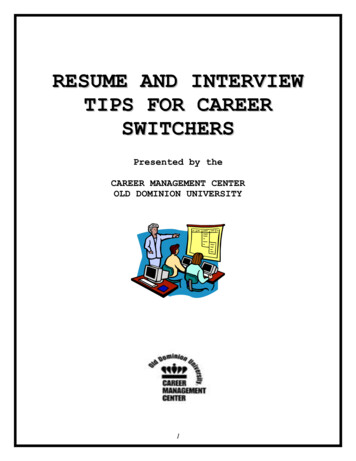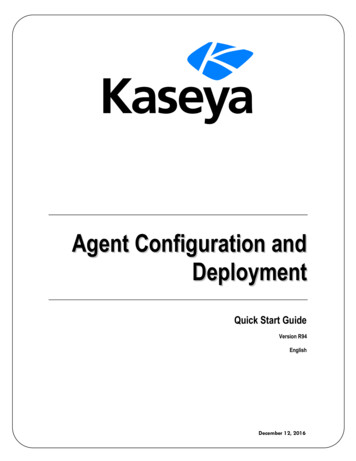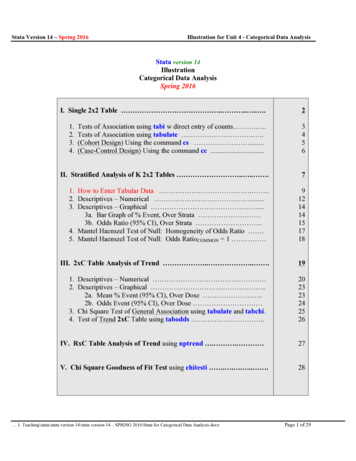
Transcription
RESUME AND INTERVIEWTIPS FOR CAREERSWITCHERSPresented by theCAREER MANAGEMENT CENTEROLD DOMINION UNIVERSITY1
Table of ContentsResume Writing Steps, Do It Right the First Time. .1Action Words. . .3Sample Resumes .425 Interview Questions 6Professional Qualities and Personal Characteristics 7Additional Assistance .82
Resume Writing StepsDo It Right the First Timeour resume’s only job is to get you aninterview. That’s it. Successful jobseekers understand the importance ofthe following steps.Y2. Career ObjectiveState what position you are seeking anddescribe your skills, abilities, experience andinterest which back up your candidacy.Step One: Identify Your Skills andAbilitiesThis is the most important activity that youcan do to prepare a solid, understandableresume. Your effectiveness in generatinginterviews will depend on your ability tocommunicate your skills and competencies toemployers. Remember, your skills aretransferable from one environment to another.Always think about which types of employerscan use someone with your abilities.Identifying your skills from the get-go willhelp you to: Create a tight and meaningful job objective. Develop an action-oriented resume. Select a resume format that highlights youraccomplishments. Match yourself to the job.3. EducationList your degrees, majors and minors. Includeyour GPA if above 3.0. State the date youwill graduate. Identify the schools attendedand city, state where they are located. Includeany academic honors, awards, scholarships,projects or publications. Military service canbe listed as an educational experience. Placemost recent degree information first. Please,no high school information. Create a list of allrelevant courses that complement your careerobjective.4. Work ExperienceDescribe any paid and non-paid experiencesthat have given you workplace skills. Detailyour title, employer name, location, dates ofemployment, and responsibility. Focus on thework you performed, your contributions,achievements, and what skills youused/gained while there. Be specific—usenumbers, figures and descriptions of theenvironment. You’ll need to give the reader amental picture of the experience.Step Two: Conduct a Self-InventoryReview your personal information andexperience. Start with a blank piece of paperand list each item that has relevance. This isnot your resume—that will come in the nextstep. Instead, now is the time to get therelevant information out of your head andcommit it to paper. Go for volume here, focuson details and specifics. You will condenseand hone this information later.5. College, Community and PersonalInvolvementState name of organization and what role youplayed in participation. Don’t just listorganizations; instead state contributions,offices held and demonstrated skills. Includedates of membership.1. Contact InformationState your full name, current and temporaryaddresses, telephone numbers, and e-mailaddress.6. OrganizationsList memberships, offices held, dates,projects, certifications and licensure.3
statement will set the tone for your resumeand give the reader an idea of whatinformation they will find on the rest of thepage.7. Special SkillsDetail skills in foreign languages, computerhardware and software, and laboratory skills.8. Interests and ActivitiesAgain, no lists. Instead detail any hobbies andendeavors that support your career objective.More TipsThere may be hundreds of resumes sitting onan employer’s desk. The challenge is to makeyour resume positively stand out. To elicit apositive reaction, do the following: Everything on your resume needs to supportyour objective. Place the most relevant information first. Get to the point quickly. Employers passover lengthy statements. Career switchers may also want to use asummary statement after the objectivestatement to highlight qualification. Keep it neat and organized. Ensure that itcan be read in less than one minute. Abbreviations should be avoided. Names and addresses of references shouldnot be included on your resume. List thisinformation on another sheet of paper andbring it with you to interviews. Include thename, title, business address, phone number,fax and e-mail address of each person.Step Three: Choose a Resume FormatThe skills you choose should reflect your ownpersonal situation. Consider yourqualifications, career objective, experience,and the kind of employer you are seekingbefore you select a style. The most commonformats are:Combination Chronological-functionalResume: This resume is good for careerchangers with a solid employment historywho want to highlight qualifications andrecent preparation for a career change.Functional Resume: Highlights thequalifications, skills and relatedaccomplishments with little emphasis ondates.Step Four: Write Your ResumeDescribe your experience in terms of whatyou accomplished. Use action verbs tostrengthen descriptions of experience.Employers are interested in how successfulyou were in the past; it predicts futureperformance.Make It ClearEliminate personal pronouns like “I” and“my.” Do not use full sentences. Instead, useshort phrases in past tense for past experience,present tense for present activity.Step Five: Critique Your First DraftAfter you are satisfied with your first typeddraft, ask several individuals who are familiarwith the type of employment you are seekingto review it.Step Six: Write a Final Draft and Make ItLook ProfessionalPrint your resume on 24 lb. cotton bondpaper. Use pure white, cream, ecru or beigepaper. Avoid pastels, grays or showy designs.These colors will not reproduce well if theemployer decides to make copies or forwardyour resume via fax. Never have a copycenter photocopy your resume onto qualitypaper; it is not good enough for your resume.Always print your resume using a laser orhigh-quality inkjet printer.Objective StatementYour objective statement specifies the type ofposition you desire and the skills andexperience you can offer. It should be workcentered, not self-centered, and shouldemphasize what you can bring to the position,not what the position can do for you. This4
Action WordsUse some of these action words in your stributeddramatizeddrew rvicedset rkedwrote
CombinationChronologicaland FunctionalResumeBILL DOE123 Grove StreetBaltimore, MD 12345(310) 683-1111bdoe135@hotmail.comOBJECTIVE To obtain a mathematics teaching position at the secondary school level SUMMARY OF QUALIFICATIONSTeach basic math skills to middle school studentsSeven years of training and supervisory experienceGreat role model as a tutor and scout leaderAdapt easily to new concepts and ideasEDUCATION Career Switcher Program, emphasis in MathematicsOld Dominion University, Norfolk, VADec 2004Bachelor of Science, Mechanical EngineeringUniversity of Maryland, College Park, MDMay 1997RELATED COURSEWORKInstruction strategiesHuman growth, development and special needsGeneral classroom management and lesson plan presentationsRecognizing child abuse and neglectReading and writing across curriculumRELATED EXPERIENCETutor and Mentor, Washington Middle School, Columbia, MDSep 1997 – presentthth Tutor 7 and 8 grade math students with homework and study skills Created the first after school study hall for math studentsBoy Scout Leader, Baltimore, MDJun 1995 – present Plan and coordinate all scouting activities for thirty five boysEXPERIENCESenior Engineer, NASA, Greenbelt, MDJun 1997 - present Conduct classroom training for newly hired engineers Supervise 15 international engineers in the development of futuristic aircrafts Develop and design test engines for future space aircrafts with an operatingbudget of over 60 million dollars ADDITIONAL INFORMATIONHonorary member of the National Education AssociationNASA employee of the year for 20016
FunctionalResumeReferences available upon requestSARA DOE123 Grove StreetMiami, FL 12345(757) 683-0111sdoe114@yahoo.comOBJECTIVE To obtain a social studies teaching position at the middle school level SUMMARY OF QUALIFICATIONSSocial studies substitute teacher for two school yearsExperienced in developing lesson plansCoordinated, planned, and supervised class tripsExperienced in working with children from diverse cultural backgroundsEDUCATIONCareer Switcher Program, emphasis in Social StudiesOld Dominion University, Norfolk, VAAug 2004Bachelor of Science, Business AdministrationMiami University, Miami, FLMay 1999RELATED COURSEWORK Instruction Strategies, Learning Styles, Human Growth andDevelopment, General Classroom Management, Recognizing Child Abuse and Neglect, andGeneral Classroom Management PlanQualificationsTeaching: Taught social studies classes as a substitute teacher to 7th and 8th grade students forschool years 2002 – 2004. Developed lessons plan and excelled in classroom management.Training: Established and coordinated the first training program for newly assigned collegegraduates. Developed the first customer-training program in the district. Created lesson plansand study guides.Supervision: Supervise six store managers in the daily operation of one of the top retail storesin the country. Created an environment, which allows for success through mentoring andteaching.Management: Establish goals and objectives for six retail stores with sales in excess of 8million dollars. Prepare daily sales reports.EXPERIENCEDistrict Manager, Blockbusters, Miami, FlFreshman Orientation Leader, University of Miami, Miami, FLReference available upon request7Jun 99 – PresentJan 97 – May 99
25 INTERVIEW QUESTIONSevery teacher should be ready to answerThe interview is the single most important factor in the hiring process. To be competitive, itis important to be prepared to respond to potential employers’ questions and discussiontopics. Take the time to think about these items that may be part of your next interview.25Questionsyoushould beable toanswer.1. Describe your past teaching experiences. What made themsuccessful?2. What are your strengths? Weaknesses?3. How would other describe you? How would you describe yourself?4. What if ? (Scenario questions can deal with situations, topics, andtrends.)5. How have you challenged your students in the classroom?6. Describe teaching strategies you have used for students includinggifted students, second-language students, reluctant learners, andspecial needs students.7. How do you incorporate your teaching philosophy into your dailyinstruction?8. What experiences have you had with volunteers in your classroom?9. Describe an effective teacher.10. Define collaboration and give examples from personal experiences.11. What are your plans for self-growth and how will you achieve them?12. How have you individualized instruction for your students?13. Tell me about the type of learning environment you create.14. Identify the characteristics of an outstanding principal.15. Tell me about yourself.16. What strategies have you used in working with parents?17. What technology do you need in your classroom to promote a goodlearning environment? What specific technology skills do youpossess?18. What are some of the strategies you have used in managing yourclassroom?19. Describe how you develop lesion/unit plans for your subject area.20. Identify ways in which you have motivated students.21. In what ways have you incorporated critical thinking skills into yourinstruction?22. How have you implemented multicultural/gender-free practices inyour teaching?23. What assessment and evaluation strategies do you use for studentlearning and for your own personal and professional performance?24. Visualize an ideal classroom. What does it look like? Who’s in it?What resources are you using? What are your goals?Accomplishments?25. What motivated you to enter the teaching profession?HandoutTeacher Interview Training Packet 1996 by Anthony and Roe8
KEYProfessional Qualities and PersonalCharacteristics Employers SeekEmployersshare their“secrets” aboutthe professionalqualities mostimportant fornew teachers. Asyou prepare tointerview forpositions,carefully identifyyour qualitiesand be ready toshare them withhiring ities soughtin teacherapplicants. Theylook for teacherswho are:Professional QualitiesDEDICATION to teaching and learningEXPERTISE in subject areaCOMMITMENT to the success of each studentKNOWLEDGE of effective teaching and classroommanagement practicesUNDERSTANDING of learning theories and how tomake instruction relevant to the learnerABILITY to team within and across departments andgrade levelsPersonal operativeEnthusiasticHonestand those who have aSense of HumorHandoutTeacher Interview Training Packet 1996 by Anthony and Roe7
For additional assistance, please contact the following:Nash MontgomeryAssociate Director and Liaison, College of Education(757) 683-4388 or email nmontgom@odu.eduor checkout our website athttp://www.odu.edu/ao/cmc/resumes.htmlCareer Management Center2202 Webb CenterNorfolk, VA 23529Other helpful hannels/clearinghouse/HandoutTeacher Interview Training Packet 1996 by Anthony and Roe7
EDUCATION Career Switcher Program, emphasis in Mathematics Old Dominion University, Norfolk, VA Dec 2004 Bachelor of Science, Mechanical Engineering University of Maryland, College Park, MD May 1997 REELLAATTEEDD KCCOOUURRSSEEWWOORRK Instruction s











